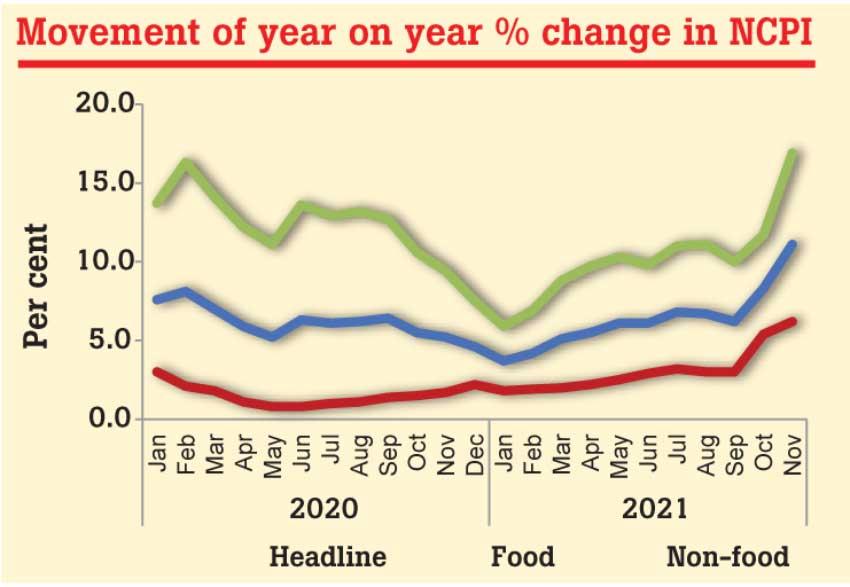22 Dec 2021 - {{hitsCtrl.values.hits}}

Sri Lanka’s consumer prices at national level climbed double digits in November over the same month last year, touching the highest level since the statistics office began compiling the data for the broader price index in 2015 as the country has entered a period of elevated prices of food and other essential commodities such as cooking gas and fuel.
Consumer prices measured by the National Consumer Price Index (NCPI) climbed 11.1 percent in the twelve months to November 2021, accelerating from 8.3 percent in October.
Meanwhile, the monthly prices also rose the most by 3.1 percent, hitting the fastest increase ever recorded, rising from 2.1 percent in October, reflecting how quickly the prices had gone up in the economy.
The so-called core inflation measured by eliminating the often volatile items such as food, energy and transportation rose by 8.8 percent in the year to November, its highest ever.
Sri Lanka’s headline prices measured by the Colombo Consumer Price Index—the authorities’ most preferred price gauge—climbed 9.9 percent in November predominantly on the soaring food prices, which jumped 17.5 percent.
ICRA Lanka last week cautioned that the country had entered an era of elevated prices, which could get entrenched through the next few months before seeing any signs of abating as the world’s major central banks last week began ending their pandemic era policy stimulus, which sloshed markets with cash for nearly two years, to combat decades of high prices.
Bank of England became the first major Central Bank to raise its benchmark interest rates from 0.1 percent to 0.25 percent last week while the United States (US) Fed doubled the pace of winding down its bond buying programme and penciled in three rate hikes for next year.
However, the raging Omicron variant in the West and the Europe could complicate the monetary policy normalising trajectory as some countries began re-imposing restrictions and part of Europe is in lockdowns in a bid to contain what has now been proven as a highly transmissible mutation.
As of yesterday, Omicron became the dominant strain in the US after 73 percent of all new coronavirus cases came from the new variant.
Meanwhile, the national food prices climbed 16.9 percent from a year earlier levels, accelerating from 11.7 percent in October while the monthly food prices rose by a shocking 5.5 percent in November over 1.9 percent increase recorded in October.
Price of vegetables, rice, milk powder, big onions, fresh fish, chicken, potatoes, coconuts, sugar, bread, and many others in the food basket rose with only a handful of items coming down from their month earlier levels, that too by very little proportions.
The non-food prices rose by 6.2 percent in the year through November, accelerating from 5.4 percent in October. But the monthly prices eased to 1.0 percent from 2.4 percent October as there were bigger price revisions coming from cooking gas and milk powder during October.
However, dropping another bombshell the government in the wee hours of December 21 raised the fuel prices by large proportions amid higher global oil prices and the depleting foreign reserve position of the country.
This will have a cascading effect across both non-food and food prices adding further fuel to the already high inflation in the coming months, making it a nightmare specially to the low income earners and the country’s large lower middle class.
16 Nov 2024 2 hours ago
16 Nov 2024 2 hours ago
16 Nov 2024 3 hours ago
16 Nov 2024 3 hours ago
16 Nov 2024 5 hours ago